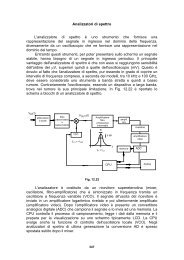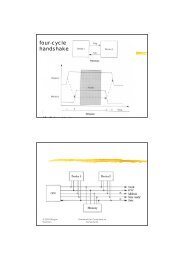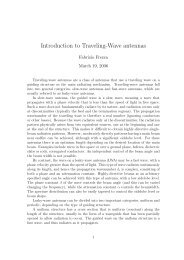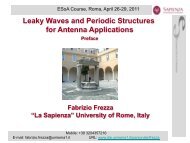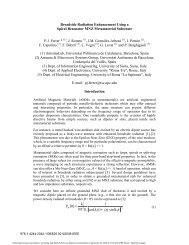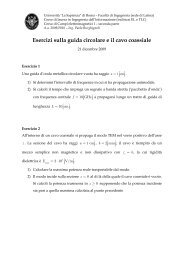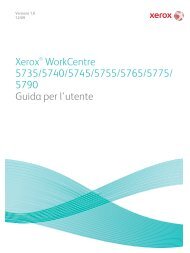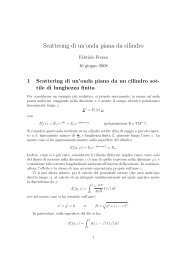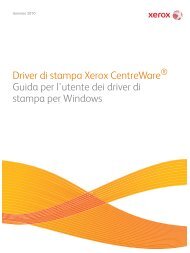Shielding Effectiveness of a Metamaterial Slab
Shielding Effectiveness of a Metamaterial Slab
Shielding Effectiveness of a Metamaterial Slab
You also want an ePaper? Increase the reach of your titles
YUMPU automatically turns print PDFs into web optimized ePapers that Google loves.
Finally, in the homogenization process, a finitethickness h eff has to be associated to the homogeneousslab equivalent to the periodic structure, which takes intoaccount the fringing fields at the top and bottom layers<strong>of</strong> the structure. In particular, an equivalent thicknessequal to Nd will be adopted, in order to best match thereflection performance <strong>of</strong> the actual periodic structureand that <strong>of</strong> its homogenized model, as it will be shown inthe next sections.III. SHIELDING EFFECTIVENESSLet us thus consider a uniform plane waveimpinging on a homogeneous planar screen whichseparates two half-spaces filled with vacuum and whichis characterized by its relative constitutive parameters ε r ,µ r , its conductivity σ, and its thickness h. As is wellknown, with the considered type <strong>of</strong> electromagneticsource, its electric and magnetic shieldingeffectivenesses coincide and are equal toESE = 20logSE = 20logEdB lin twhere E i and E t indicate the electric fields <strong>of</strong> the incidentand transmitted plane waves, respectively. Thecalculation <strong>of</strong> the shielding effectiveness can easily beperformed by means <strong>of</strong> the usual transmission-lineanalogy, thus obtaining [9]whereRdBdBi(6)SEdB = RdB + AdB + MdB(7)= 20log R=20logA = 20log A=20log e( Z + Z )0 S4ZZjkxSh0 S⎛Z0 S − j2kxShMdB= 20log M = 20log 1−⎜ ⎟ eZ0 + ZS⎝2− ZThe impedances Z 0 and Z S depend on the TE or TMpolarization <strong>of</strong> the incident plane wave and on the angle<strong>of</strong> incidence θ i throughZZη η µ= , Z =TE 0 TE 0 r0 i ScosθkxSη kTM i TM 0 xS0= η0cos θ , ZS=ε rc⎞⎠2(8)(9)2 iwhere kxS = k 0 µ rεrc − sin θ and εrc = εr − jσ / ω(being k0 = ω µ 0ε0 and ω = 2π f ).When a planar metal screen is considered, theshielding effectiveness expression (7) can be furthersimplified (the propagation constant k xS is very large andpractically unaffected by the angle <strong>of</strong> incidence), so thatSElincησ32πf⎛⎜⎝πησf⎞c ⎟⎠0 0 exp h(10)When a lossless wire-medium screen is considered,characterized by an effective permittivity as in (1) andoperating below the plasma frequency, the followingexpression for the shielding effectiveness is obtainedinstead:SElin⎡ ⎤c 1 ⎢ 2π⎥ exp⎢N⎥ (11)4dfdd2πln ⎢ ln ⎥4r⎢0 ⎣ 4r⎥0 ⎦The explicit calculation <strong>of</strong> the shielding effectiveness <strong>of</strong> alossy wire-medium screen is just a bit more involved,since the imaginary part <strong>of</strong> the effective permittivity (asgiven in (4)) has to be taken into account.IV.NUMERICAL RESULTSA. Validation <strong>of</strong> the Homogenized ModelIn order to validate the adopted analysis technique,based on the homogenization <strong>of</strong> the metamaterial, fullwavesimulations have been performed <strong>of</strong> actual periodicwire-medium layers in free space with a commercials<strong>of</strong>tware based on the finite integration technique (CSTMicrowave Studio TM ) [10].In Fig. 2 a representative example is shown, for astructure constituted by N = 5 layers <strong>of</strong> perfectlyconducting wires with parameters d = 100 mm, r 0 = 0.1mm, ε rh = 1 (wires in vacuum). These values have beenchosen in order to obtain values <strong>of</strong> the shieldingeffectiveness not too large (lower than 80 dB in theconsidered frequency range), so avoiding inaccuracies due tonumerical noise.The homogenized slab has f p = 486 MHz, calculatedwith (2). The choice <strong>of</strong> the equivalent slab thickness is amore delicate matter. In fact, on one hand, the absence <strong>of</strong>a dielectric host slab containing the wires does not allowone to identify ‘natural’ interfaces between the




